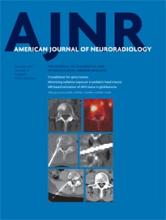Research ArticleNeurointervention
Open Access
A New Aneurysm Occlusion Classification after the Impact of Flow Modification
H.S. Cekirge and I. Saatci
American Journal of Neuroradiology January 2016, 37 (1) 19-24; DOI: https://doi.org/10.3174/ajnr.A4489
H.S. Cekirge
aFrom the Department of Radiology (H.S.C), Bayindir Hospital, Ankara, Turkey
I. Saatci
bDepartment of Radiology (I.S.), Yüksek Ihtisas University, Koru Hospital, Ankara, Turkey.

References
- 1.↵
- Molyneux A,
- Kerr R,
- Stratton I, et al
- 2.↵
- McDougall CG,
- Spetzler RF,
- Zabramski JM, et al
- 3.↵
- Campi A,
- Ramzi N,
- Molyneux AJ, et al
- 4.↵
- Molyneux AJ,
- Birks J,
- Clarke A, et al
- 5.↵
- Johnston SC,
- Dowd CF,
- Higashida RT, et al
- 6.↵
- Molyneux AJ,
- Kerr RS,
- Birks J, et al
- 7.↵
- Crobeddu E,
- Lanzino G,
- Kallmes DF, et al
- 8.↵
- Fiorella D,
- Lylyk P,
- Szikora I, et al
- 9.↵
- Ding YH,
- Lewis DA,
- Kadirvel R, et al
- 10.↵
- Roy D,
- Milot G,
- Raymond J
- 11.↵
- Raymond J,
- Guilbert F,
- Weill A, et al
- 12.↵
- Mascitelli JR,
- Moyle H,
- Oermann EK, et al
- 13.↵
- Mascitelli JR,
- Oermann EK,
- De Leacy RA, et al
- 14.↵
- O'Kelly CJ,
- Krings T,
- Fiorella D, et al
- 15.↵
- Kamran M,
- Yarnold J,
- Grunwald IQ, et al
- 16.↵
- Grunwald IQ,
- Kamran M,
- Corkill RA, et al
- 17.↵
- Lubicz B,
- Klisch J,
- Gauvrit JY, et al
- 18.↵
- Saatci I,
- Yavuz K,
- Ozer C, et al
- 19.↵
- Yavuz K,
- Geyik S,
- Saatci I, et al
- 20.↵
- Dai D,
- Ding YH,
- Kadirvel R, et al
- 21.↵
- Pierot L,
- Liebig T,
- Sychra V, et al
- 22.↵
- Becske T,
- Kallmes DF,
- Saatci I, et al
- 23.↵
- Kadirvel R,
- Ding YH,
- Dai D, et al
- 24.↵
- Dai D,
- Ding YH,
- Rezek I, et al
In this issue
American Journal of Neuroradiology
Vol. 37, Issue 1
1 Jan 2016
Advertisement
H.S. Cekirge, I. Saatci
A New Aneurysm Occlusion Classification after the Impact of Flow Modification
American Journal of Neuroradiology Jan 2016, 37 (1) 19-24; DOI: 10.3174/ajnr.A4489
0 Responses
Jump to section
Related Articles
Cited By...
- Impact of Smoking on Recurrence and Angiographic Outcomes after Endovascular Treatment of Intracranial Aneurysms: A Systematic Review and Meta-analysis
- Evaluation of flow diverters for cerebral aneurysm therapy: recommendations for imaging analyses in clinical studies, endorsed by ESMINT, ESNR, OCIN, SILAN, SNIS, and WFITN
- Magnetic resonance perfusion imaging findings following flow diversion in patients with complex middle cerebral artery bifurcation aneurysms: a single-center analysis regarding the jailed cortical branches
- Surpass Intracranial Aneurysm Embolization System Pivotal Trial to Treat Large or Giant Wide-Neck Aneurysms - SCENT: 3-year outcomes
- Management of aneurysmal recurrence after Woven EndoBridge (WEB) treatment
- Triple therapy versus dual-antiplatelet therapy for dolichoectatic vertebrobasilar fusiform aneurysms treated with flow diverters
- Prospective study on embolization of intracranial aneurysms with the pipeline device (PREMIER study): 3-year results with the application of a flow diverter specific occlusion classification
- Brain aneurysm and parent vessel remodeling after flow diversion treatment: a proposed modification for Cekirge-Saatci classification (mCSC)
- First clinical multicenter experience with the new Pipeline Vantage flow diverter
- Predictors of incomplete aneurysm occlusion after treatment with the Pipeline Embolization Device: PREMIER trial 1 year analysis
- Triple therapy versus dual-antiplatelet therapy for dolichoectatic vertebrobasilar fusiform aneurysms treated with flow diverters
- Long-term safety and efficacy of distal aneurysm treatment with flow diversion in the M2 segment of the middle cerebral artery and beyond
- Changing the Rules of the Game: The Problem of Surrogate Angiographic Outcomes in the Evaluation of Aneurysm Treatments
- Middle Cerebral Artery Bifurcation Aneurysms Treated by Extrasaccular Flow Diverters: Midterm Angiographic Evolution and Clinical Outcome
This article has not yet been cited by articles in journals that are participating in Crossref Cited-by Linking.
More in this TOC Section
Similar Articles
Advertisement











